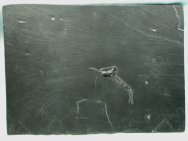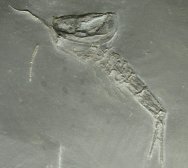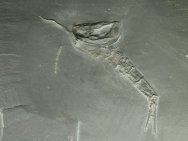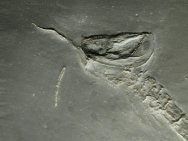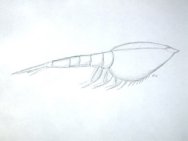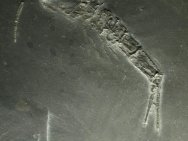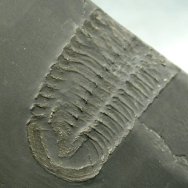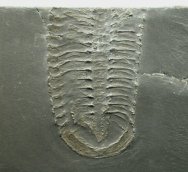Nahecaris
steurtzi Phyllocarid
Subphylum
Crustacea, Class Malacostraca, Subclass Phyllocarida
and
Chotecops
ferdinandi Trilobite
Trilobites
Order Phacopida, Family Phacopidae
Geological
Time: Lower Devonian, Seigenian/Emsian Stage (~390 million years ago)
Size: Nahecaris
fossil is 68 mm long Chotecops fossil is 37 mm long by 24 mm across
on a 200 mm by 145 mm matrix
Fossil Site:
Hunsrück Slate, Bundenbach Germany
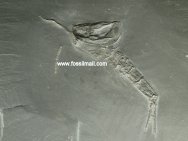 Description:
This unusual Phyllocarid arthropod is known as Nahecaris steurtzi.
Phyllocarids are one of the lesser-known branchiopod crustaceans
from the Cambrian where they are among the earliest animals with
a hard shell. They have a fairly large carapace, which protects
the anterior part of the body. This structure hinged along the dorsal
edge like a bivalve. Usually only the Description:
This unusual Phyllocarid arthropod is known as Nahecaris steurtzi.
Phyllocarids are one of the lesser-known branchiopod crustaceans
from the Cambrian where they are among the earliest animals with
a hard shell. They have a fairly large carapace, which protects
the anterior part of the body. This structure hinged along the dorsal
edge like a bivalve. Usually only the 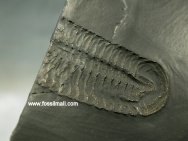 carapace
is found. Rarely are the soft parts preserved. To better interpret
this wonderful specimen, I have included a photograph of an X-Ray
(below left) that was taken. I will include the original with the
specimen to the person lucky enough to acquire this exceptional
example. carapace
is found. Rarely are the soft parts preserved. To better interpret
this wonderful specimen, I have included a photograph of an X-Ray
(below left) that was taken. I will include the original with the
specimen to the person lucky enough to acquire this exceptional
example.
The
Hunsruck slate is famous for its fossils, many of which have pyritization
present. Rapid burial and pyritization was what led to the many
wonderful examples of early Devonian life from the region. The chemistry
of the silt was such that low organic content and high levels of
iron and sulfur allowed the pyrite to diffuse into the tissues rather
than be deposited in the sediment. The mudstones were metamorphosed
into slate during the Carboniferous. The slate was quarried for
roofing tiles, and the quarrymen would save 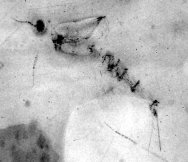 the
fossils for later sale. Now that the quarries are no longer open,
future supplies of these wonderfully preserved benthic organisms
will only come from existing collections. the
fossils for later sale. Now that the quarries are no longer open,
future supplies of these wonderfully preserved benthic organisms
will only come from existing collections.
Found
on the reverse is a trilobite known as Chotecops, seen here with
preserved limbs, making this a most unusual association plaque.
While the price may seem high, soft tissue preservation in Nahcaris
is EXCEEDINGLY rare. Specimens without ANY soft tissue have commanded
$1500 prices at recent international fossil expositions. I’ve
included an artist’s rendering of the similar Phyllocarid
known as Ceratiocaris. |
|



